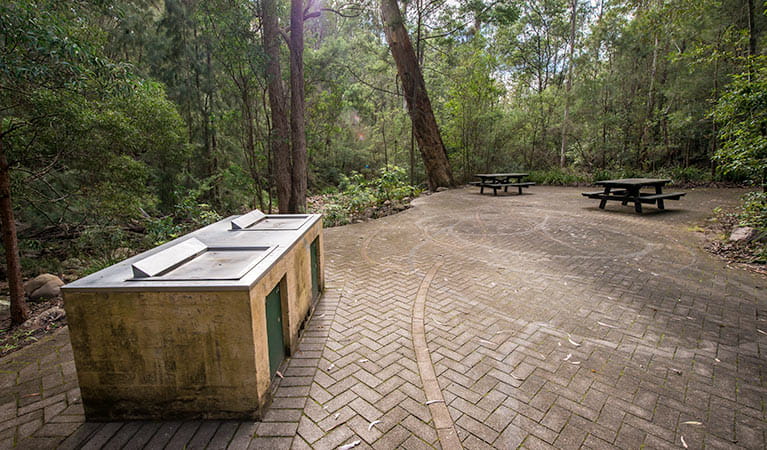Biamanga Cultural area
Biamanga National Park
Overview
Biamanga Cultural area offers visitors to Biamanga National Park a scenic place to picnic and enjoy the short walk to a lookout with views over Mumbulla Falls and a beautiful gorge.
- Type
- Picnic areas
- Where
- Biamanga National Park in South Coast
- Accessibility
- Medium
- What to
bring - Hat, sunscreen
- Please note
The Aboriginal custodians request that visitors, through respect, do not swim in the Mumbulla Falls area - a site that is sacred to the Yuin People.
A great way to take advantage of the natural splendour of Biamanga National Park is by stopping at Biamanga Cultural area during your road trip.
You'll find a convenient boardwalk – perfect for walking with children – that leads to a scenic lookout where you can see water cascading through a dramatic gorge and granite boulder field. This is part of the legacy of an ancient shield volcano in the area, and the story of its Aboriginal heritage is conveyed through interpretive signs and an information shelter here.
Don't forget your camera – the forest setting is beautiful, with eastern water dragons sunning themselves on rocks and chefs cap correa bursting with lemon and green colours. Birdwatching is superb as well – with azure kingfishers and blue wrens frequenting the area, it’s almost as though they're putting on a show for visitors.
After your stroll, unpack a lunch at one of the picnic tables or fire up the free gas barbecues for a relaxing afternoon with family and friends beneath the eucalypts. This is a great picnic spot, shady and serene, surrounded by the calming sounds of the rushing creek.
Map
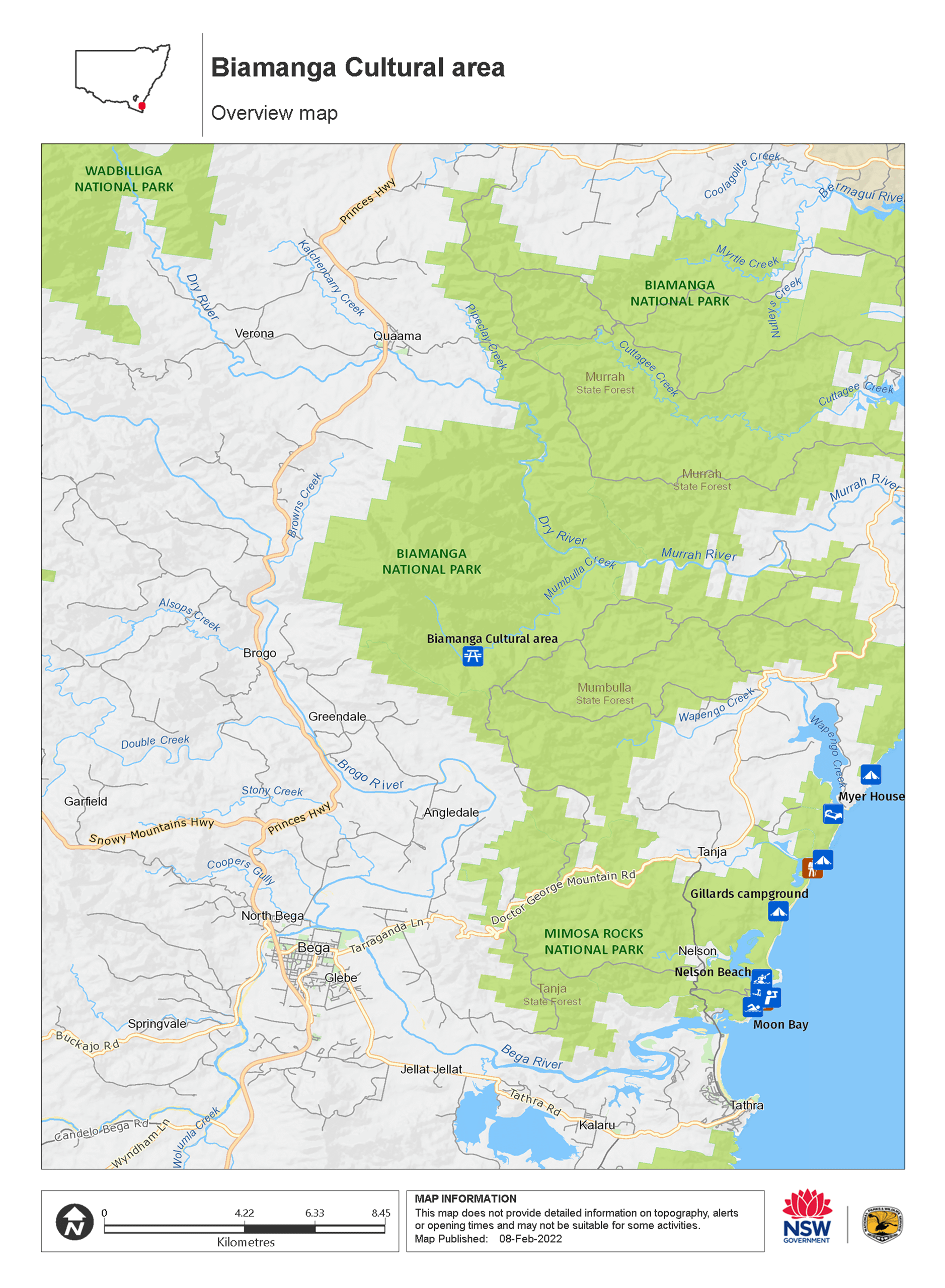
Map legend

Local alerts
For the latest updates on fires, closures and other alerts in this area, see https://www.nationalparks.nsw.gov.au/things-to-do/picnic-areas/biamanga-cultural-area/local-alerts
General enquiries
- National Parks Contact Centre
- 7am to 7pm daily
- 1300 072 757 (13000 PARKS) for the cost of a local call within Australia excluding mobiles
- parks.info@environment.nsw.gov.au
Park info
- in Biamanga National Park in the South Coast region
Biamanga National Park is always open, but may have to close at times due to poor weather or fire danger.
Visitor info
All the practical information you need to know about the Biamanga Cultural area.
Getting there and parking
Biamanga Cultural area is 23km north of Bega. To get there from Bega:
- Drive north-east along Dr George Mountain Road
- Turn left on to Mumbulla Creek Road at the Biamanga Cultural Area sign
- Continue along Mumbulla Creek Road and turn left at the intersection with Tee Ridge Road, to remain on Mumbulla Creek Road
- Turn right on to Mumbulla Creek Falls Road and follow the signs to the Biamanga Cultural Area carpark
Please note: there is no access to Biamanga National Park from the Princes Highway via Clarkes Road, as this is private property.
Road quality
Check the weather before you set out as the road to Biamanga Cultural area can become boggy when it rains.
- Unsealed roads
Vehicle access
- 2WD vehicles (no long vehicle access)
Weather restrictions
- Dry weather only
Parking
Parking is available at Biamanga Cultural area carpark. It can be a busy place on the weekend, so parking might be limited.
Best times to visit
There are lots of great things waiting for you in Biamanga National Park. Here are some of the highlights.
Spring
See the chefs cap correa flowers hanging from their stems, and bring binoculars for some excellent birdwatching opportunities.
Summer
Escape the heat of the sun by settling down for a picnic in the cool shade near Mumbulla Creek Falls. Goannas are regular visitors in the warmer months.
Weather, temperature and rainfall
Summer temperature
Average
13.9°C and 26.6°C
Highest recorded
44°C
Winter temperature
Average
2.3°C and 17.3°C
Lowest recorded
-8.1°C
Rainfall
Wettest month
March
Driest month
August
The area’s highest recorded rainfall in one day
454.2mm
Facilities
Drinking water is not available in this area, so it’s a good idea to bring your own.
Toilets
- Flush toilets
Picnic tables
Barbecue facilities
- Gas/electric barbecues (free)
Carpark
Maps and downloads
Accessibility
Disability access level - medium
- Assistance may be required to access this area.
Prohibited
Camp fires and solid fuel burners
Gathering firewood
Pets
Pets and domestic animals (other than certified assistance animals) are not permitted. Find out which regional parks allow dog walking and see the pets in parks policy for more information.
Smoking
NSW national parks are no smoking areas.
Learn more
Biamanga Cultural area is in Biamanga National Park. Here are just some of the reasons why this park is special:
A precious haven
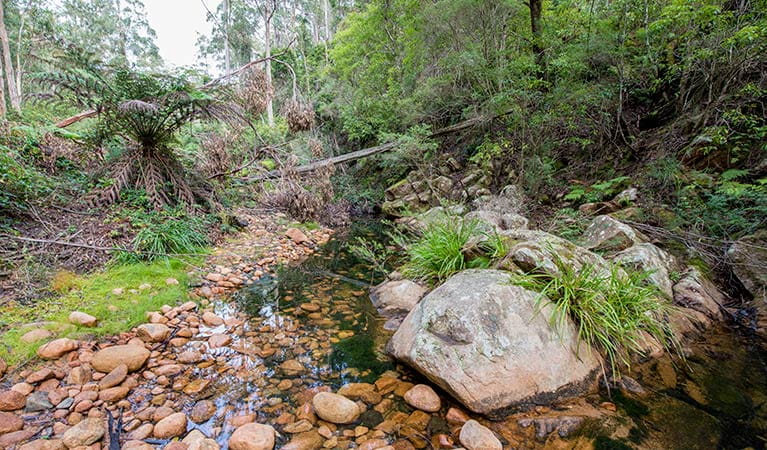
Biamanga National Park conserves an important area of substantially pristine coastal foothill environments, with monkey and ribbon gums clustered around the creekbeds. It also contains the endangered chefs cap correa, an unusual lemon and green flower that looks exactly like its namesake. The shrubs are endemic to NSW and popular with local birds. The park is also home to an array of wildlife, from goannas and eastern water dragons to swamp wallabies and some of the last remaining koalas in the south-eastern corner of NSW. Birds are also plentiful, including lyrebirds, azure kingfishers, flycatchers and blue wrens.
Volcanic legacy
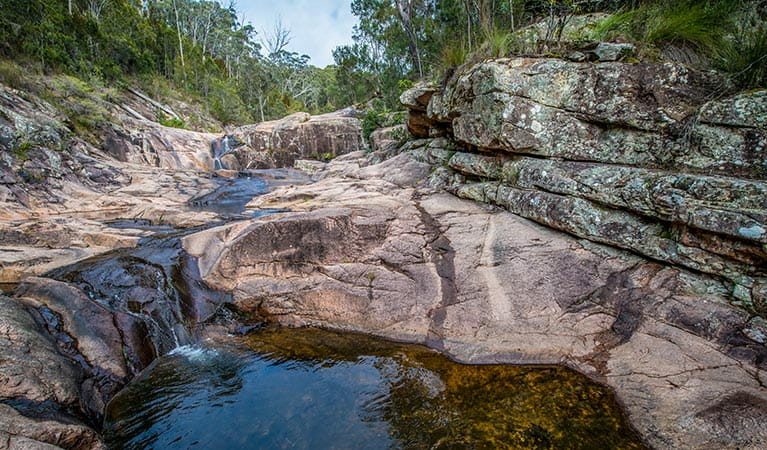
Biamanga (also known as Mumbulla Mountain) rises in the middle of Biamanga National Park, and is largely the legacy of an ancient shield volcano. You can see this most clearly through a granitic creek corridor with massive boulders and plunge pools. This is the course of Mumbulla Creek, which rushes toward the coast from its origins up in the mountain. This park conserves an important area of substantially pristine coastal foothill environments, with monkey and ribbon gums clustered around the creekbeds. It also contains the endangered chefs cap correa, an unusual lemon and green flower that looks exactly like its namesake. The shrubs are endemic to NSW and popular with local birds.
- Biamanga Cultural area Biamanga Cultural area offers visitors to Biamanga National Park a scenic place to picnic and enjoy the short walk to a lookout with views over Mumbulla Falls and a beautiful gorge.
Yuin Country
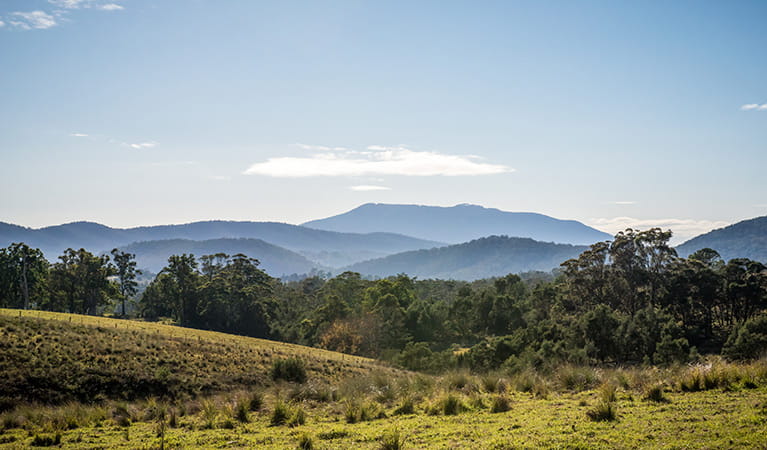
The landscape of Biamanga National Park is sacred to the Yuin People, ancient custodians of this land, who maintain their strong traditional ties to it today. In 2006, the park became jointly managed by the Aboriginal community and NPWS. There are a number of cultural sites throughout the area with spiritual significance for the Yuin. The best place to learn about these is Mumbulla Creek Falls, where interpretative signs detail the Aboriginal history of the region.
- Biamanga Cultural area Biamanga Cultural area offers visitors to Biamanga National Park a scenic place to picnic and enjoy the short walk to a lookout with views over Mumbulla Falls and a beautiful gorge.

